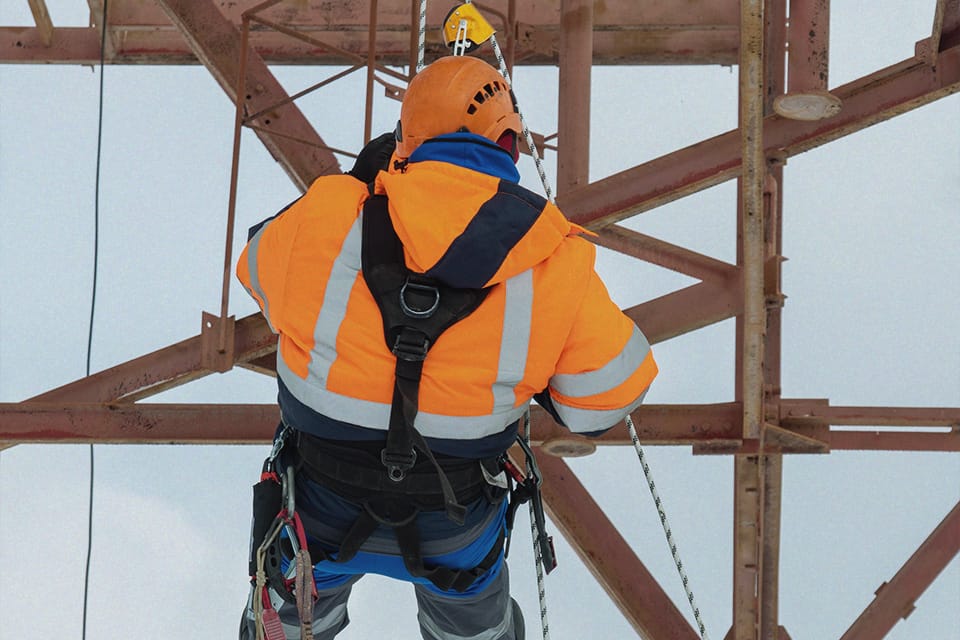
Getting Ready for Winter — What Safety Leaders Need to Know Now | Risk Matrix Episode 118
THE RISK MATRIX Cutting-edge podcast on occupational safety and risk management. Hosted by industry titans: JAMES JUNKIN, MS, CSP, MSP,…

The increasing globalization and reliance on technology have led to a significant rise in the number of telecommunication towers worldwide (Ribeiro et al., 2021). These structures, vital for maintaining long-distance communication, require regular maintenance. However, maintaining these structures exposes workers to significant occupational safety risks. This article investigates these risks, highlighting the critical safety concerns and proposing recommendations for improvement.
Recent research and the author’s personal experience unveiled four major occupational hazards related to work on telecommunications towers: falling objects, falls from height, electrocution, and animal attacks. Surprisingly, a significant portion of the occupational safety items assessed (80%) were found to be non-compliant within regulatory standards (Ribeiro et al., 2021).
This stark statistic underlines the urgent need for enhanced safety procedures and compliance enforcement within the industry. A literature review for this article with findings was compared to the OSHA’s potential draft standard addressing telecommunication tower safety, showing a critical gap in actual practice versus established standards.
A recent Deep Dive Contractor HSE Assessment of a contractor company working on telecommunication towers exemplified several of the common shortcomings identified in the study. The team, composed of a supervisor, a technician, and a support worker, had a combined working experience of 13 years. However, despite this experience, they lacked adequate risk assessment procedures. This resulted in a high level of non-compliance with safety regulations.
The team did not perform any pre-work risk assessments. Their adherence to basic safety measures such as proper use of Personal Protective Equipment (PPE) and regular inspections was also deficient. Only 20% of their checklist items conformed to OSHA standards.
The team’s training and procedures regarding working at heights were lacking. Although equipped with harnesses and other safety equipment, the team’s understanding and implementation of fall protection measures did not meet required standards, placing the workers at elevated risk of injury.
The assessments employed the Hazard Rating Number (HRN) method, a numerical process used to estimate the risk associated with a hazard and quantify the identified risks. The HRN considers the severity of potential harm, frequency of exposure, probability of damage, and the number of people at risk. Using this system, falling objects and falls from height were classified as “high” risk, electrocution as “unacceptable,” and attacks from animals as “low.”
The assessment categorized the risks and prioritized the most severe. The electrocution risk, for instance, is often linked to non-compliance with safety procedures, inadequate training, and the absence of necessary safety equipment. Falls from height remain a major concern, attributable to inadequately secured equipment, and the failure to utilize approved fall arrest systems. The analysis of the risks underscores that despite the high number of potential hazards, many companies do not fully implement proper safety management systems, increasing the risk of accidents (Vila et al., 2020).
The assessments proposed various recommended control measures. They are categorized as elimination, substitution, engineering controls, procedures, administrative controls, supervision, training and certification, signalization, and the use of Personal Protective Equipment (PPE). These measures address the identified risks, focusing on preventative steps to minimize the likelihood of accidents and reduce severity.
Specific examples include the implementation of electric winches for hoisting antennas to reduce manual handling risks, the installation of safety barriers and guardrails to prevent falls, and comprehensive training programs to ensure workers’ familiarity with safe work practices. The assessment highlights the importance of a multi-faceted approach that integrates both technological and human factors to improve overall safety.
Comprehensive Deep Dive Contractor HSE Assessments of telecommunications contractors have repeatedly emphasized the critical role of adequate training and procedural compliance in preventing accidents. The lack of proper training in electrical safety, working at heights, and the use of PPE is a recurring theme throughout these assessments.
Regular inspections and audits are also crucial in identifying and rectifying potential hazards before they escalate into accidents. The assessments highlighted the benefits of hazard and risk identification and the identification of controls in the early stages of planning and design and construction of telecommunication towers, supporting a more preventative and safer approach.
Recent Deep Dive Contractor HSE Assessments have examined the occupational safety risks associated with the maintenance of telecommunication towers. These assessments have powerfully demonstrated the significant gap between existing safety standards and actual practices.
The high prevalence of non-compliance, particularly in areas such as PPE usage, proper training, and adherence to fall protection procedures, underscores the urgent need for industry-wide improvements. The recommendations made by the assessors advocate for a combination of engineering controls, improved training, and stricter adherence to safety regulations, offer a vital framework for enhancing workplace safety and reducing the incidence of accidents in this specialized sector.
By prioritizing worker safety through enhanced risk management, improved training, and the implementation of preventive measures, the industry can significantly reduce the occurrence of costly and often tragic accidents. The OSHA draft standard (Occupational Safety and Health Administration, 2018) regarding telecommunication tower safety would offer a further step toward risk prevention.
James A. Junkin, MS, CSP, MSP, SMS, ASP, CSHO is the chief executive officer of Mariner-Gulf Consulting & Services, LLC and the chair of the Veriforce Strategic Advisory Board and the past chair of Professional Safety journal’s editorial review board. James is a member of the Advisory Board for the National Association of Safety Professionals (NASP). He is Columbia Southern University’s 2022 Safety Professional of the Year (Runner Up), a 2023 recipient of the National Association of Environmental Management’s (NAEM) 30 over 30 Award for excellence in the practice of occupational safety and health and sustainability, and the American Society of Safety Professionals (ASSP) 2024 Safety Professional of the Year for Training and Communications, and the recipient of the ASSP 2023-2024 Charles V. Culberson award. He is a much sought after master trainer, keynote speaker, podcaster of The Risk Matrix, and author of numerous articles concerning occupational safety and health.
Alanko, T., Hietanen, M., & von Nandelstadh, P. (2008). Occupational exposure to RF fields from base station antennas on rooftops. Annals of Telecommunications – Annales des Télécommunications, 63(1-2), 125-132. https://doi.org/10.1007/s12243-007-0001-6
Barkokébas Junior, B., Zlatar, T., Cruz, F. M., Lago, E. M. G., Martins, A. R. B., & Vasconcelos, B. M. (2020). Segurança e saúde do trabalho para uma cultura prevencionista no ambiente laboral. Recife: Editora da Universidade de Pernambuco.
Occupational Safety and Health Administration. (2018). Telecommunications Towers Preliminary Initial Regulatory Flexibility Analysis. OSHA Small Business Advocacy Review Panel. https://www.osha.gov/sites/default/files/TelecommunicationsTowersPIRFA.pdf
Ribeiro, R. F., Barkokébas Junior, B., Lago, E. M. G., Martins, A. R. B., Cruz, F. M., & Zlatar, T. (2021). Occupational safety risks during maintenance of telecommunication towers. Production, 31, e20200108. https://doi.org/10.1590/0103-6513.20200108
Vila, N. A., Cardoso, L., & Toubes, D. R. (2020). Occupational risk prevention in the management of companies in the electricity sector: The case of Galicia (Spain). Journal of Scientific and Industrial Research, 79, 30–34. http://nopr.niscair.res.in/handle/123456789/53467
Zlatar, T., & Barkokébas Junior, B. (2018). Building information modelling as a safety management tool for preventing falls from height. Germany: LAMBERT Academic Publishing.
Zlatar, T., Lago, E. M. G., Soares, W. A., Baptista, J. S., & Barkokébas Junior, B. (2019). Falls from height: Analysis of 114 cases. Production, 29, e20180091. https://doi.org/10.1590/0103-6513.20180091


THE RISK MATRIX Cutting-edge podcast on occupational safety and risk management. Hosted by industry titans: JAMES JUNKIN, MS, CSP, MSP,…
We’ll send you practical and insightful supply chain risk management info that can benefit your business. Plus, important company updates that keep you in the loop.
